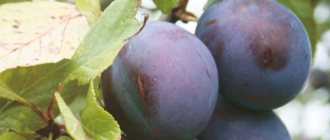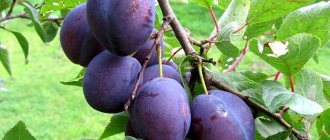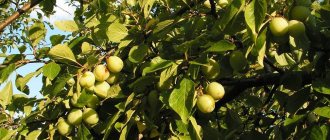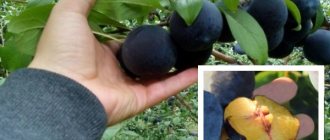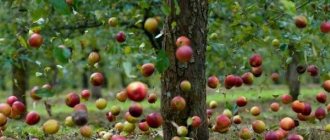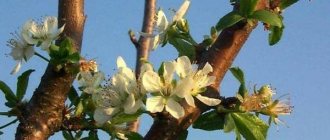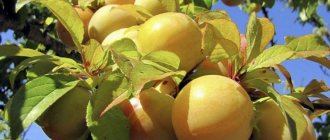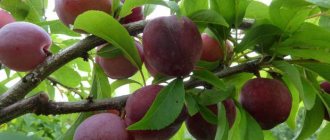Description of the plum variety Black Tula
The variety has several other names:
- Tula prunes;
- Winter blue;
- Meshchovsky prunes;
- Bryansk late.
The tree and fruit have their own special characteristics.
The Tula plum grows up to 4.5 m in height. It has a small, dense, oval crown. The leaves have a dark green tint.
According to the photo of the black plum, the fruit looks like an egg. They cannot boast of large sizes. The weight of the plum reaches a maximum of 30 g. The color of the fruit is dark blue, sometimes with a red tint. There is a bluish coating on the skin.
The pulp of plums is yellow-green, dense, juicy. It tastes sweet. According to tasters, it deserves a rating of 4.1 points out of 5 possible for taste.
Attention! A tree grown in the southern regions bears tastier fruits.
Growing the Black Tulskaya plum works best in the Moscow region. The variety is also widespread in the Tula and Kaluga regions.
Reviews
Amateur, Moscow
To solve the problem with winter hardiness and pollination, I planted the Black Tula plum. And for skeletal education I make vaccinations of any variety I want. Otherwise, the climate does not allow for growing a good harvest.
Ingvar
Old local variety. Mine ripens in mid-September. The taste is not bad, but jam turns out tastier. And the liqueur in general is simply awesome! We also call this variety Tula prunes, although it has nothing to do with prunes. You can also find this name - Bryansk local.
Characteristics of the variety
The main characteristics of this variety of plum relate to its resistance to adverse weather conditions, fertility, and resistance to certain diseases.
Drought resistance, frost resistance
The Black Tulskaya variety does not tolerate a lack of moisture very well. Due to drought, unripe fruits fall to the ground.
Reviews of the “Tulskaya Chernaya” plum in the Moscow region indicate that its winter hardiness level is average. The tree quickly recovers after a frosty winter.
Pollinators of plum Chernaya Tulskaya
The variety is considered self-fertile. It does not need pollinators for stable fruiting. This is one of its main advantages.
Productivity and fruiting
The “Black Tulskaya” variety produces fruit regularly. Gardeners watched her for 17 years. During this period there was no harvest only 4 times.
The variety's yield level is average. Usually this is about 10 kg of fruit per tree. The maximum value is 35 kg.
Area of application of berries
Black Tula plum is used to prepare various dishes and preparations. This is juice, compote, jam, jam, liqueur. But it is worth remembering that due to the high juiciness of the fruit, preserves and jams turn out to be too liquid.
Resistance to diseases and pests
A pleasant characteristic of the Black Tulskaya plum variety is its resistance to certain types of diseases and pests. The tree is not susceptible to clasterosporiosis and fruit rot.
Advantages and disadvantages of the variety
The Black Tula plum has a number of advantages.
- Stability of fruiting.
- Good yield (maximum 35 kg per tree).
- High taste ratings.
- Easy to separate pulp and pits.
- The tree does not suffer from clasterosporiosis and rot.
Flaws:
- average level of winter hardiness;
- fruit shedding due to lack of moisture;
- influence of weather conditions on taste.
Another significant drawback is the susceptibility to the fatty stem.
Harvesting
The fruits of the Tulia black plum ripen in early to mid-September. The average yield is about 15 kg per tree, the maximum yield exceeds 30 kg.
Plums that will be stored for some time should be removed along with the stem. Fruits are placed in boxes in 3-4 layers. At 5°C and 80% humidity they will keep in the refrigerator for 2 weeks.
This variety is more suitable for processing than for fresh consumption. However, due to the juiciness of the fruit, the canned food is a little thinner, but it makes excellent jams, juices and compotes.
Tula black plum is well suited for processing
Landing Features
How correctly the tree was planted depends on its health and productivity.
Recommended timing
The time for planting seedlings depends greatly on the region. If this is the Moscow region and surrounding areas, it is better to plant in the spring. In a few warm months, seedlings will not only be able to adapt to new conditions, but also prepare for winter.
It is better to start planting 5 days after the snow melts. The entire process takes 2 weeks. If you start it later, during the period of sap flow, the plum will take root poorly.
In regions with mild winters, autumn planting is preferable. We need to get there before the cold weather sets in. The ideal month for planting is October.
Attention! Plum seedlings of the “Black Tulskaya” variety, which have a closed root system, can be planted in the ground at any time of the year.
Choosing a suitable location
As mentioned above, the taste of the Black Tulskaya plum directly depends on the amount of sunlight. The more sun, the sweeter the fruits will be. That is why seedlings should be planted not in the shade, but in a place open to light. However, they must be protected from the wind. Therefore, the best option is space near the house or fence.
It is better to choose loam from the soil. It is good if groundwater lies at a depth of 1-1.2 m.
It is not recommended to plant plums on heavy, acidic, alkaline or cold soil. Clay will also not work. On it, the root system will be partially located on the surface, which is why it may suffer from severe frosts or air deficiency.
Restrictions are also imposed on sandstones. Such soil has no nutrients at all, and it dries out quickly.
Too low areas are also not suitable for planting the Black Tulskaya plum variety. Cold air accumulates in them. In addition, they are more susceptible to flooding than others.
What crops can and cannot be planted nearby?
It is not recommended to plant the following plants next to the Black Tulskaya tree:
- Walnut;
- hazelnut;
- fir;
- birch;
- poplar.
The proximity of a plum to a pear is also considered unfavorable. However, this applies to cases where the trees are very close to each other.
The Black Tula plum has good or neutral relationships with apple trees and black currants. You can also plant thyme, tulips, daffodils, and primrose near it.
Selection and preparation of planting material
The Black Tula plum seedlings selected for planting must meet several simple requirements.
- Age no more than 2 years.
- The presence of one conductor and three side shoots is a minimum.
- The roots are 35-40 cm long. It is important that the root system does not have growths or overgrowths.
To protect the seedlings during transportation, their roots must be covered with a cloth soaked in water. Wrap the top with polyethylene.
Landing
You will live long on your personal plot and enjoy delicious plum harvests only if you follow the planting rules and basic agricultural techniques.
Choosing a seedling
The best place to purchase seedlings will be a local fruit nursery.
The requirements for the seedling should be as follows:
- age ( 1–2 years );
- number of side shoots ( at least 3 );
- healthy root system (root length is 30 cm , they are moistened, do not have growths or abscesses);
- proportions of planting material (height not less than 120 cm , diameter of the central shoot from 2 cm and length of lateral branches 50–60 cm ).
Planting time depends on the cultivation area. So, in the Moscow region and in the middle zone it is better to carry out all the work in the spring; in the southern regions you can plant plums in the fall, in October. In the case of a closed root system, planting time does not play a big role.
Landing area
It is best to place the plum near a wall or fence to protect it from cold winds and drafts.
As a soil, loam would be the best option. You should not plant plums in soil that is too acidic, heavy or alkaline, clay or sandstone, which dries out quickly.
The site should be well lit, have no shadow, and be located on a small hill no closer than 2 meters to groundwater.
Preparation
The planting pit for plums is prepared depending on the type of soil.
The planting hole is prepared in the fall if planting is scheduled for spring and 2-3 weeks in advance if in the fall. The soil in this place is dug up with a mixture of superphosphate and potassium salt ( 50 g/30 g ). A hole with a radius of 40 cm is dug to a depth of 80 cm. The extracted soil is mixed with peat, potassium sulfide and superphosphate.
Stages of work
On the day of planting, half the soil is sent back to the hole, a plum is planted there on the mound, a peg is driven in nearby, after which everything is covered with the remains of the soil.
The soil is compacted, spilled and mulched with dry peat in a layer of 10–12 cm . The distance between seedlings should not be less than 3 meters .
Unwanted neighbors
Undesirable neighbors include birch, poplar, fir, as well as walnuts and hazelnuts.
Do not plant pear crops next to plums. But apple trees will not interfere with the plum variety. The same applies to black currant bushes, thyme, tulips and primrose.
Landing algorithm
Planting of the Black Tula plum is carried out in several stages.
- About 2 weeks before planting, dig up the ground (radius 2 m) and add fertilizer (8 kg of humus, 50 g of superphosphate and 30 g of potassium salt).
- Dig a hole (depth 60 cm, width 70 cm). Combine the earth with peat (2 buckets), superphosphate (300 g) and potassium sulphide (80 g). Pour the mixture into the hole to fill 2/3 of its volume.
- Drive a small peg into the hole.
- Place the “Black Tula” plum seedling in the hole, carefully straighten the roots, and cover with soil. It is important that the root collar is 5-7 cm above the ground.
- Form an earthen roller at a distance of 40 cm from the tree.
- Water the ground with 2 buckets of clean water.
- As soon as the water is absorbed, cover the soil with humus or peat (10 cm).
Several plums of this variety should be planted at a distance of 3 m from each other.
Aftercare for plums
Proper planting and care of the Black Tula plum is the key to a healthy tree and a good harvest. Not a single detail should be overlooked, be it gradual pruning or fertilization.
There are two types of pruning of this type of tree: formative and sanitary. It is held every year.
- After planting, it is necessary to shorten the central trunk of the tree so that it is 25 cm higher than the branches.
- At 2 years of age, the formation of a sparsely layered crown begins. It is recommended to leave the 3 strongest branches. Cut the shoots to 60 cm. It is important that the central trunk still remains 20-25 cm higher than the other branches.
- At 3 years old, the formation of 2 tiers of the crown should begin. It is located 40 cm from the first and consists of 2 branches.
- At 4 years old you need to make the 3rd tier.
- Starting from the 5th year, it is necessary to trim only those branches that make the crown too thick.
Sanitary pruning of plants of this variety is carried out as necessary and does not depend on the age of the plum. It involves removing damaged or diseased branches. It is also recommended to remove root shoots, which have a bad effect on the nutrition and growth of the tree.
As mentioned above, the Black Tula plum variety does not cope well with drought. For this reason, special attention should be paid to watering. During the growing season, you need to water the tree 6 times:
- after the flowers fall;
- 2 weeks after the first watering;
- 2 weeks after the second watering;
- during the period of fruit ripening;
- after the harvest is harvested;
- in September – October.
Feeding is also carried out according to the seasons.
| Season | young tree | Tree bearing fruit | Consumption per 1 tree |
| May | 2 tbsp. l. urea, 2 tbsp. l. liquid humate and 10 liters of water | 20 l | |
| June | 3 tbsp. l. nitrophoska and 10 liters of water | 20 l | |
| August-early September | 3 tbsp. l. potassium sulfate, 3 tbsp. l superphosphate, 10 l water | 20 l | |
| Early spring | 25 g urea, 20 g potassium chloride, 60 g superphosphate | ||
| September October | 10 kg manure (rotted)/10 kg compost |
Another important part of caring for the Black Tula plum variety is its preparation for winter. It starts in October. First of all, the soil around the tree must be cleared of fallen leaves and dug up (20 cm). Afterwards, you need to fill the plum with 70 liters of water and cover it with sawdust or a 10-centimeter layer of peat.
To protect the plant from rodents, the trunk should be whitened. After this, wrap it with a layer of roofing material, glass wool and light-reflecting foil.
Care
Caring for the Tula black plum is very simple. But you should not neglect simple rules, otherwise you may be left without a harvest.
Trimming
For the Tula Black variety, a sparsely tiered crown shape is suitable. Ventilation of foliage and uniform lighting will help the fruits grow large and sweet.
The plum crown is given a sparsely tiered shape
- If the plum is planted in the spring, then the formation of the crown begins immediately after planting. Trees planted in autumn must wait until next spring.
- A sparsely-tiered crown involves from 5 to 7 strong branches that will form the basis of the crown. They should depart from the trunk at an angle of 45 - 500 (the angle of inclination at a young age can be easily corrected with a rope).
- Annuals are pruned at a height of 70–80 cm from the ground surface. In two-year-olds, the branches that will become the basis of the first tier and the central conductor are determined. The skeletal branches are shortened by 1/3, and the main one after pruning should be 20 - 30 cm higher than the side ones. The shoots located on the trunk are cut into a ring, the skeletal ones - into a lateral bud.
- The next year, the side branches and the central conductor are moderately shortened (to keep it straight, the cut is made on the opposite side from last year's pruning). The trunk is also cleared of overgrown branches, and competing branches growing deeper are cut out.
- Next spring, in order to control the height of the plum, the central conductor is cut at a height of 2.5 m. At the end of July, when the crown has grown with new shoots and foliage, you can assess how thick the crown is and remove all excess.
- Further pruning should maintain the crown in a sparse state and control the growth of the central conductor.
In the fall, a preventive inspection of plums is carried out. Sick and broken branches must be removed. During the decline of growth, light rejuvenating pruning is carried out, shortening the branches to 3–4-year-old wood.
All work should be carried out only with sharpened garden tools. After the procedure, the sections are sealed with garden varnish to avoid possible infections.
A sharp garden tool is required for pruning.
Watering
The most demanding watering plants are young seedlings, especially in the first year of planting. To build up the root mass and healthy growth, one tree requires a bucket of water 4 - 5 times a month. When creating a watering schedule, take into account weather conditions.
Plum seedlings are very demanding when it comes to watering.
Adult fruiting plums have their own watering schedule:
- after flowering;
- In 2 weeks;
- during the formation of the ovary;
- during fruit filling;
- after harvest;
- autumn watering in October, but if the weather is rainy, then this stage can be skipped so that a swamp does not form around the plum.
Since the Tula black plum is a compact tree, 2–3 buckets of water per tree will be enough to water it.
The most important watering is when the fruits ripen. During this period, the plum intensively lays buds for the future harvest.
The drip irrigation method is very good, allowing moisture to penetrate evenly and gradually deep into the soil. If this is not possible, then you need to water the plum in 2 doses - morning and evening. If you pour it all out at once, the moisture will remain under the crown for a long time. And in hot weather this will lead to evaporation and increased humidity around the tree. If this happens constantly, fungal diseases may appear.
Drip irrigation allows moisture to be evenly absorbed into the soil
Fertilizers
Fertilizers added to the planting hole will last for 2 years. And then you should take care of feeding the tree. In order for the plum to have enough strength for spring growth, fruit set and an abundant harvest, 3 feedings are carried out per season.
Table: fertilizing for fruiting plums
| Period | Top dressing |
| Before flowering begins. | A solution of 10 liters of water and potassium sulfate and urea, taken 35 g each. Fertilizer is applied to moist and loosened soil in the root area. The norm for 1 tree is 30 – 35 liters. |
| Pouring fruit. | Dilute 30 g of nitrophoska and urea in 10 liters of water. One tree needs 25 - 30 liters of solution. |
| When the harvest is complete. | 30 g of potassium sulfate and superphosphate per 10 liters of water. The norm is 30 – 40 liters per 1 plum. |
For a seedling, the fertilizer application scheme looks slightly different. The first feeding should contain nitrogen to help the plant quickly begin to grow. You can use urea or liquid fertilizer Ideal - 2 tbsp. l. for 10 liters of water. Further maintenance of the young tree (before fruiting begins) occurs according to the following scheme.
Table: fertilizing seedlings
| When to Apply Fertilizer | What fertilizer to use |
| In the beginning of May. | Dilute 2 tbsp in 10 liters of water. l. urea or 3 tbsp. l. growth stimulator sodium humate. |
| The beginning of June. | Nitrophoska - 2 tbsp. l. for 10 liters of water. |
| Mid August. | Per bucket of water - 2 tbsp. l. potassium sulfate and superphosphate. |
| Up to 30 liters of solution is consumed per 1 seedling. | |
In addition to mineral fertilizers, plums are very responsive to organic matter. Well-rotted manure (10–15 kg) is applied no more than once every 2–3 years during autumn digging.
Properly fertilized Tula black plum will not skimp on the harvest
Tree trunk care
To ensure that the Tula black plum does not lack moisture, the trunk circle is loosened after each watering or rain. By breaking up the crust that has formed on the soil surface, you also help to establish gas exchange in the roots. Manual weeding and cutting out root shoots is the prevention of many types of pests. Mulching is also a necessary element of care. Mulch perfectly retains moisture in the soil and prevents weeds from growing.
Mulch retains moisture in the soil and prevents weeds from germinating
Caring for plums in autumn and preparing for winter
How the plum will survive the winter depends on the quality of the autumn work carried out.
- In September, the area under the crown is cleared of fallen leaves, weeds, broken branches and fallen fruits. This must be done so that there is no place for pests and diseases to overwinter.
- The tree trunk circle is carefully dug up.
- The trunk is cleared of old bark, damaged areas are removed and the wounds are sealed with garden pitch. Then whitewash is applied.
- To protect the branches from diseases and pests, it is sprayed with a urea solution.
- By wrapping the trunk with a mosquito net, you will protect the plum from rodents.
In autumn, the tree trunk circle is carefully dug up
An adult plum, planted in the right place and cared for, does not need to be wrapped for the winter. The only measure that protects the roots from frost is a thick layer of mulch.
Seedlings need more reliable protection. Frail trunks need to be reliably protected from frost. Any non-woven covering material, cardboard, newspaper, burlap or nylon tights can be used as an improvised blanket. The main requirement is good air and moisture conductivity. You can tie the tree with spruce or pine branches, securing them with the needles down. By the way, such a shelter will also protect you from rodents.
Materials that do not allow air to pass through are not suitable. Under them, the tender bark of the seedling may begin to rot.
The spruce branches will not only protect you from frost, but will also save you from rodents.
Diseases and pests, methods of control and prevention
The plum variety “Chernaya Tulskaya” is not susceptible to clasterosporia and fruit rot. However, it may suffer from other diseases or pests.
| Disease | Symptoms | Treatment | Prevention |
| Plum pockets | The fruit stretches out and becomes flat. The bone does not appear. Up to 30% of the entire crop is affected. | Treat the wood with a 0.2% copper oxychloride solution. | Destroy infected fruits, thin out the crown, feed the plum with calcium-based fertilizers. |
| Gum treatment | Small honey-like drops appear on the trunk. Through the wounds, infection enters the tree. | Clear the trunk of growths. Disinfect the wounds with a 1% solution of copper sulfate and cover them with garden pitch. | Carry out pruning according to schedule. Protect young trees from frost. Regularly check the condition of the tree as a whole. |
| Moniliosis | Withering of branches, flowers and leaves. | Before flowering, treat the tree with 3% Bordeaux mixture or copper oxychloride. | Treat plum trees for pests in a timely manner. Burn fallen leaves and branches. |
| Dwarfism | A viral disease that affects leaves and peduncles. The first ones change shape, become denser and at the same time fragile. | There is no cure. The diseased plum needs to be dug up and destroyed. | Buy seedlings only from trusted gardeners or nurseries. When working, use only clean tools. Get rid of pests in a timely manner. |
| Smallpox | Spots appear on the leaves. Dark dents form on the fruit. | Uproot the tree and burn it. | Preventive measures are the same as in the previous case. |
Of the pests, the plum "Black Tula" is most often affected by the thick stalk, yellow sawfly and codling moth.
- Chlorophos, Karbofos or Mospilan, diluted in water according to the instructions, will help get rid of the fatty leg.
- The same drugs as in the previous case help fight yellow sawfly.
- Chlorophos can protect plums from codling moths. Treatment is usually carried out in mid-June.
Important! Timely digging and destruction of damaged fruits will help prevent plums from being damaged by pests.
The plum "Black Tula" was liked by many gardeners. It has good yield, excellent taste, and resistance to some diseases. Like any other fruit tree, it requires constant care. If everything is done correctly and according to the schedule, the plum will delight you with fruits for many years.

